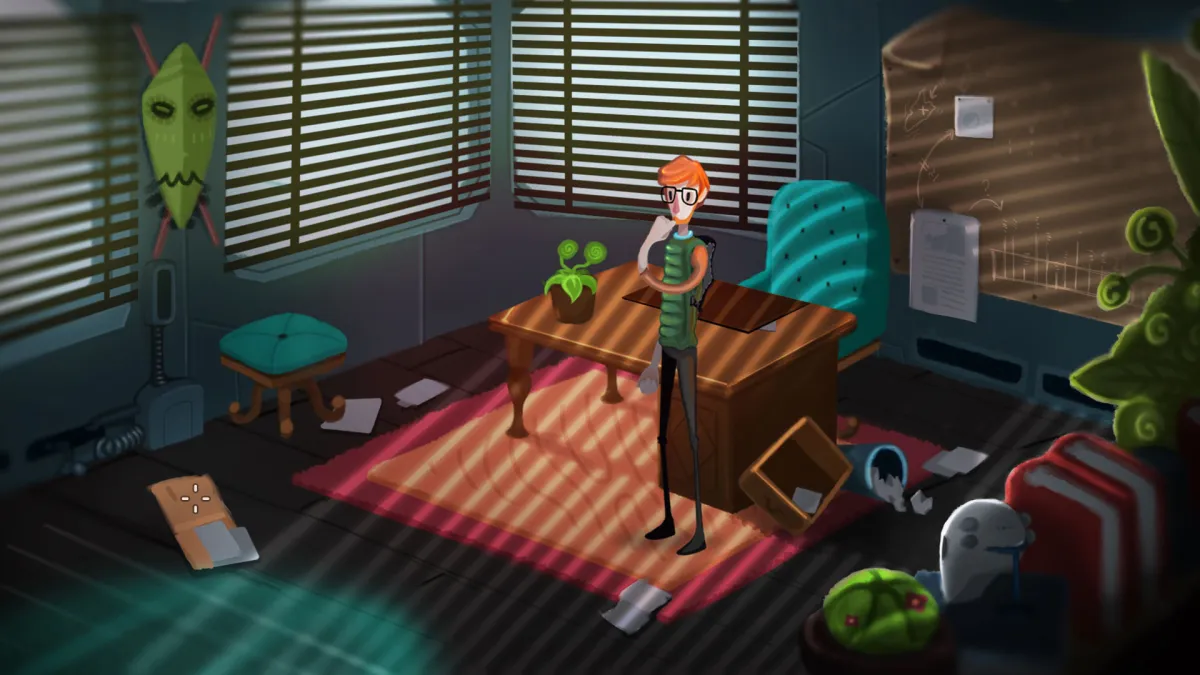The point-and-click adventure game was a staple of the late ’80s and early ’90s. Games like Monkey Island, Day of the Tentacle, and Space Quest were all the rage. But, as Mr. Dylan predicted, the times did indeed change, and the genre began to fade into obscurity. There have been several attempts to revitalize the genre to varying degrees of success. Mutropolis is a point-and-click adventure game in the same vein of those aforementioned beloved classics. It isn’t trying to reinvent the wheel, but it isn’t trying to make a better one either.
The game is set in the far flung future where civilization as we know it today has been wiped out by a mysterious cataclysm. You play as Dr. Henry Dijon, an archaeologist from Mars. Before the cataclysm struck, humanity migrated to the stars and stayed there for thousands of years until it was safe to come back to Earth. During one of your expeditions into the ruins of the old world, your mentor is kidnapped by a mysterious assailant. Now you and your team of oddballs are on a mission to rescue him by finding the lost city of Mutropolis — a city that many are convinced only exists in legends.
Mutropolis is not a very long game, but your play time will vary due to the game’s obscure puzzles. If you’re able to complete all the puzzles fairly quickly you will spend about five or six hours in between the three main hub areas. The problem comes with those puzzles, however. Point-and-click adventure games are infamous for operating on “moon logic.” Essentially, the solutions to puzzles were so random and nonsensical that it feels like only the person who designed it could figure it out without a guide. Mutropolis isn’t nearly as bad in this respect as its contemporaries. However it suffers when it comes to giving players the information they need to figure out the puzzle themselves.
Shallow space
Full disclosure: I had to use a guide to finish the game. While the results of all the puzzles make sense after you complete them, how you were supposed to come to those conclusions is often a mystery in and of itself. Because of this, I theorize that the game can double or triple in length depending on how long it takes you to complete the often obtuse puzzles. The way older games in this genre got players to stick it through was by having charming characters in a world you wanted to occupy. Even if that time was spent on figuring out how the ever-loving heck you are supposed to proceed.
To compare, the characters and world of Mutropolis aren’t bad in the slightest. However, it feels like there is so much more depth that could be explored. The setup of the world is interesting, but we barely get to see any of it. Its characters, while sometimes charming, are unfortunately one dimensional and lean on tired tropes. You have the odd nerd, the ditzy blonde, and the tough girl who is actually a big softie, among others. The humor in the game is also one-note. For a game that begins with Grumpy Cat on the loading screen (and never appeared anywhere else in the game), I expected a lot more quirkiness. Most of the humor boils down to “pop culture reference is funny because people in the future have no context for it.” You see, it’s funny, because they don’t know who” The Rock” is in the future.
To be fair, there are some genuinely funny moments and clever puzzles to break up the padding. One section of the game turns 16 bit as you control a robot helper named Max, and a few jokes got some authentic giggles out of me. However, the story never has any real sense of tension or danger. It all seems really laid back and easy going, despite the fact it involves a kidnapping. Yet, you get to the end, and then it becomes suddenly serious and weird out of nowhere. There’s a clear lack of consistency at play.
The art style is charming, but again, it feels like more could have been done with it. Or, at the very least, not try to portray heavily dramatic scenes with what amounts to stick figures with unmoving faces.
Promises for the future
There is nothing inherently bad about Mutropolis. Depending on your tolerance for these types of puzzles, the game is a mildly enjoyable, if not a slightly boring romp through an interesting world with likeable enough characters. The game is developed by Pirita Studio, a two-person team out of Madrid. Keeping that in mind, this is an impressive effort from such a small team. Most of the game’s shortcomings can be chalked up to growing pains, and I am interested to see what they do in the future.









Published: Feb 18, 2021 12:45 pm